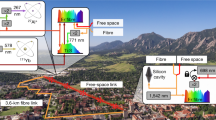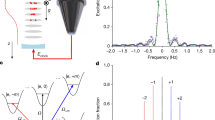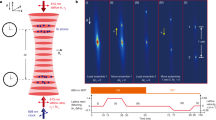Abstract
Transition frequencies of atoms and ions are among the most accurately accessible quantities in nature, playing important roles in pushing the frontiers of science by testing fundamental laws of physics, in addition to a wide range of applications such as satellite navigation systems. Atomic clocks based on optical transitions approach uncertainties of 10−18 (refs 1–3), where full frequency descriptions are far beyond the reach of the SI second. Direct measurements of the frequency ratios of such super clocks, on the other hand, are not subject to this limitation4,5,6,7,8. They can verify consistency and overall accuracy for an ensemble of super clocks, an essential step towards a redefinition of the second9. Here we report a measurement that finds the frequency ratio of neutral ytterbium and strontium clocks to be ℛ = 1.207507039343337749(55), with a fractional uncertainty of 4.6 × 10−17 and a measurement instability as low as 4 × 10−16 (τ/s)−1/2.
This is a preview of subscription content, access via your institution
Access options
Subscribe to this journal
Receive 12 print issues and online access
$209.00 per year
only $17.42 per issue
Buy this article
- Purchase on Springer Link
- Instant access to full article PDF
Prices may be subject to local taxes which are calculated during checkout



Similar content being viewed by others
Change history
15 March 2016
In the version of this Letter originally published online, in Table 2, the column heading '171Yb' was mistakenly included. This has now been corrected in all versions of the Letter.
References
Chou, C. W., Hume, D. B., Koelemeij, J. C. J., Wineland, D. J. & Rosenband, T. Frequency comparison of two high-accuracy Al+ optical clocks. Phys. Rev. Lett. 104, 070802 (2010).
Ushijima, I., Takamoto, M., Das, M., Ohkubo, T. & Katori, H. Cryogenic optical lattice clocks. Nature Photon. 9, 185–189 (2015).
Nicholson, T. L. et al. Systematic evaluation of an atomic clock at 2 × 10−18 total uncertainty. Nature Commun. 6, 6896 (2015).
Rosenband, T. et al. Frequency ratio of Al+ and Hg+ single-ion optical clocks; metrology at the 17th decimal place. Science 319, 1808–1812 (2008).
Matsubara, K. et al. Direct comparison of a Ca+ single-ion clock against a Sr lattice clock to verify the absolute frequency measurement. Opt. Express 20, 22034–22041 (2012).
Godun, R. M. et al. Frequency ratio of two optical clock transitions in 171Yb+ and constraints on the time variation of fundamental constants. Phys. Rev. Lett. 113, 210801 (2014).
Akamatsu, D. et al. Frequency ratio measurement of 171Yb and 87Sr optical lattice clocks. Opt. Express 22, 7898–7905 (2014).
Yamanaka, K., Ohmae, N., Ushijima, I., Takamoto, M. & Katori, H. Frequency ratio of 199Hg and 87Sr optical lattice clocks beyond the SI limit. Phys. Rev. Lett. 114, 230801 (2015).
Riehle, F. Towards a redefinition of the second based on optical atomic clocks. C. R. Phys. 16, 506–515 (2015).
Katori, H., Takamoto, M., Pal'chikov, V. G. & Ovsiannikov, V. D. Ultrastable optical clock with neutral atoms in an engineered light shift trap. Phys. Rev. Lett. 91, 173005 (2003).
Van Tilburg, K., Leefer, N., Bougas, L. & Budker, D. Search for ultralight scalar dark matter with atomic spectroscopy. Phys. Rev. Lett. 115, 011802 (2015).
Derevianko, A. & Pospelov, M. Hunting for topological dark matter with atomic clocks. Nature Phys. 10, 933–936 (2014).
Schive, H., Chiueh, T. & Broadhurst, T. Cosmic structure as the quantum interference of a coherent dark wave. Nature Phys. 10, 496–499 (2014).
Itano, W. M. et al. Quantum projection noise: population fluctuations in two-level systems. Phys. Rev. A 47, 3554–3570 (1993).
Häfner, S. et al. 8 × 10−17 fractional laser frequency instability with a long room-temperature cavity. Opt. Lett. 40, 2112–2115 (2015).
Dick, G. J. Local oscillator induced instabilities in trapped ion frequency standards. In Proc. 19th Precise Time Time Interval Meet. (ed. Sydnor, R. L.) 133–147 (US Naval Observatory/Goddard Space Flight Center, 1988).
Bize, S., Sortais, Y. & Lemonde, P. Interrogation oscillator noise rejection in the comparison of atomic fountains. IEEE Trans. Ultrason. Ferroelectr. Freq. Control 47, 1253–1255 (2000).
Takamoto, M., Takano, T. & Katori, H. Frequency comparison of optical lattice clocks beyond the Dick limit. Nature Photon. 5, 288–292 (2011).
Chou, C. W., Hume, D. B., Thorpe, M. J., Wineland, D. J. & Rosenband, T. Quantum coherence between two atoms beyond Q = 1015. Phys. Rev. Lett. 106, 160801 (2011).
Middelmann, T., Falke, S., Lisdat, C. & Sterr, U. High accuracy correction of blackbody radiation shift in an optical lattice clock. Phys. Rev. Lett. 109, 263004 (2012).
Bloom, B. J. et al. An optical lattice clock with accuracy and stability at the 10−18 level. Nature 506, 71–75 (2014).
Beloy, K. et al. Atomic clock with 1 × 10−18 room-temperature blackbody Stark uncertainty. Phys. Rev. Lett. 113, 260801 (2014).
Barber, Z. W. et al. Optical lattice induced light shifts in an Yb atomic clock. Phys. Rev. Lett. 100, 103002 (2008).
Katori, H., Ovsiannikov, V. D., Marmo, S. I. & Palchikov, V. G. Strategies for reducing the light shift in atomic clocks. Phys. Rev. A 91, 052503 (2015).
Inaba, H. et al. Spectroscopy of 171Yb in an optical lattice based on laser linewidth transfer using a narrow linewidth frequency comb. Opt. Express 21, 7891–7896 (2013).
Hinkley, N. et al. An atomic clock with 10−18 instability. Science 341, 1215–1218 (2013).
Takamoto, M. et al. Frequency ratios of Sr, Yb, and Hg based optical lattice clocks and their applications. C. R. Phys. 16, 489–498 (2015).
Recommended Values of Standard Frequencies (BIPM, 2013); http://www.bipm.org/en/publications/mises-en-pratique/standard-frequencies.html.
Greenhall, C. A., Howe, D. A. & Percival, D. B. Total variance, an estimator of long-term frequency stability. IEEE Trans. Ultrason. Ferroelectr. Freq. Control 46, 1183–1191 (1999).
Le Targat, R. et al. Experimental realization of an optical second with strontium lattice clocks. Nature Commun. 4, 2109 (2013).
Ma, L.-S., Jungner, P., Ye, J. & Hall, J. L. Delivering the same optical frequency at two places: accurate cancellation of phase noise introduced by an optical fiber or other time-varying path. Opt. Lett. 19, 1777–1779 (1994).
Takamoto, M. et al. Improved frequency measurement of a one-dimensional optical lattice clock with a spin-polarized fermionic 87Sr isotope. J. Phys. Soc. Jpn 75, 104302 (2006).
Angstmann, E. J., Dzuba, V. A. & Flambaum, V. V. Relativistic effects in two valence-electron atoms and ions and the search for variation of the fine-structure constant. Phys. Rev. A 70, 014102 (2004).
Lea, S. N. Limits to time variation of fundamental constants from comparisons of atomic frequency standards. Eur. Phys. J. Special Topics 163, 37–53 (2008).
Huntemann, N. et al. Improved limit on a temporal variation of m p /m e from comparisons of Yb+ and Cs atomic clocks. Phys. Rev. Lett. 113, 210802 (2014).
Uzan, J.-P. The fundamental constants and their variation: observational and theoretical status. Rev. Mod. Phys. 75, 403–455 (2003).
Arvanitaki, A., Huang, J. & Van Tilburg, K. Searching for dilaton dark matter with atomic clocks. Phys. Rev. D 91, 015015 (2015).
Falke, S. et al. A strontium lattice clock with 3 × 10−17 inaccuracy and its frequency. New J. Phys. 16, 073023 (2014).
Santarelli, G. et al. Frequency stability degradation of an oscillator slaved to a periodically interrogated atomic resonator. IEEE Trans. Ultrason. Ferroelectr. Freq. Contr. 45, 887–894 (1998).
Lemke, N. D. et al. Spin-1/2 optical lattice clock. Phys. Rev. Lett. 103, 063001 (2009).
Sherman, J. A. et al. High-accuracy measurement of atomic polarizability in an optical lattice clock. Phys. Rev. Lett. 108, 153002 (2012).
Blatt, S. et al. Rabi spectroscopy and excitation inhomogeneity in a one-dimensional optical lattice clock. Phys. Rev. A 80, 052703 (2009).
Ovsiannikov, V. D., Pal'chikov, V. G., Taichenachev, A. V., Yudin, V. I. & Katori, H. Multipole, nonlinear, and anharmonic uncertainties of Sr atoms in an optical lattice. Phys. Rev. A 88, 013405 (2013).
Lemke, N. D. et al. p-wave cold collisions in an optical lattice clock. Phys. Rev. Lett. 107, 103902 (2011).
Falke, S., Misera, M., Sterr, U. & Lisdat, C. Delivering pulsed and phase stable light to atoms of an optical clock. Appl. Phys. B 107, 301–311 (2012).
Iwakuni, K. et al. Narrow linewidth comb realized with a mode-locked fiber laser using an intra-cavity waveguide electro-optic modulator for high-speed control. Opt. Express 20, 13769–13776 (2012).
Acknowledgements
We thank H. Inaba and F.-L. Hong of AIST/NMIJ for providing the frequency comb. We thank T. Pruttivarasin for commenting on the manuscript. This work received partial support from the Japan Society for the Promotion of Science (JSPS) through its Funding Program for World-Leading Innovative R&D on Science and Technology (FIRST) and from the Photon Frontier Network Program of the Ministry of Education, Culture, Sports, Science and Technology (MEXT), Japan. N.N. acknowledges RIKEN's Foreign Postdoctoral Researcher (FPR) program for financial support.
Author information
Authors and Affiliations
Contributions
H.K. initiated and coordinated the experiments. M.T. and I.U. characterized and operated the Sr clock, N.N. and T.O. the Yb clock. N.O. maintained and operated the frequency comb. All authors contributed to the experimental set-ups, discussed the results and commented on the manuscript.
Corresponding author
Ethics declarations
Competing interests
The authors declare no competing financial interests.
Supplementary information
Supplementary information
Supplementary information (PDF 625 kb)
Rights and permissions
About this article
Cite this article
Nemitz, N., Ohkubo, T., Takamoto, M. et al. Frequency ratio of Yb and Sr clocks with 5 × 10−17 uncertainty at 150 seconds averaging time. Nature Photon 10, 258–261 (2016). https://doi.org/10.1038/nphoton.2016.20
Received:
Accepted:
Published:
Issue Date:
DOI: https://doi.org/10.1038/nphoton.2016.20
This article is cited by
-
Improved interspecies optical clock comparisons through differential spectroscopy
Nature Physics (2023)
-
A self-reference direct-measuring scheme for precision optical frequency ratio measurement
Applied Physics B (2022)
-
Simultaneous bicolor interrogation in thulium optical clock providing very low systematic frequency shifts
Nature Communications (2021)
-
Atomic clocks compared with astounding accuracy
Nature (2021)
-
Frequency ratio measurements at 18-digit accuracy using an optical clock network
Nature (2021)



